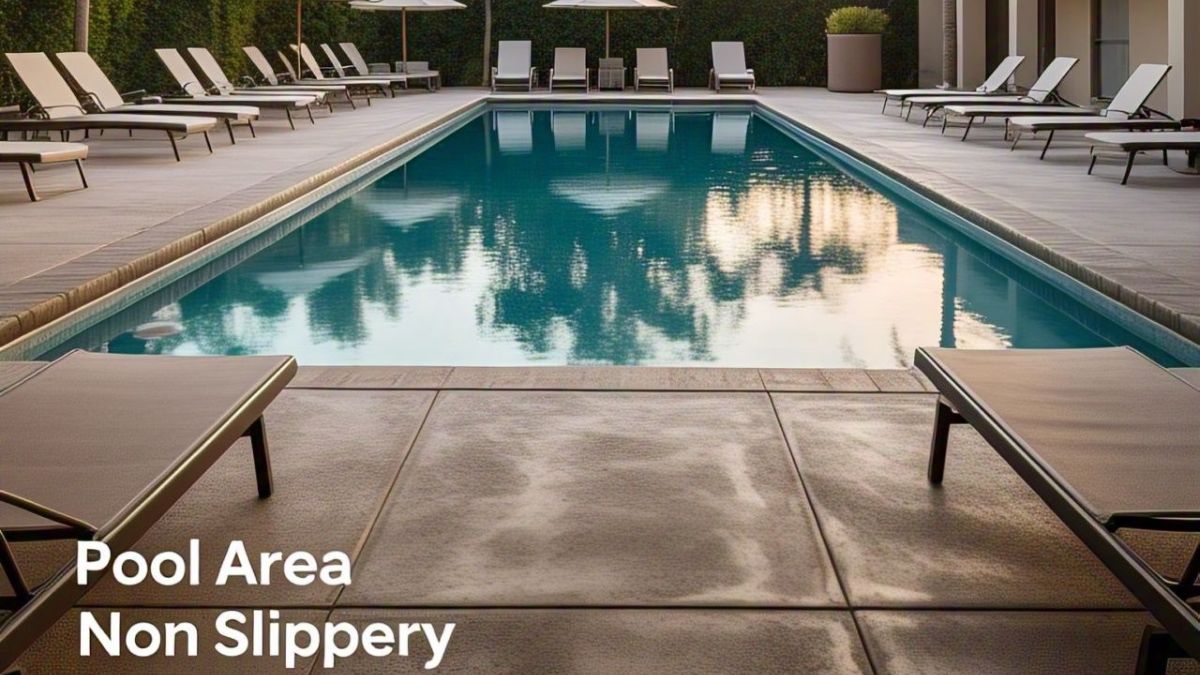Living in the Bay Area, with its stunning weather and outdoor lifestyle, a pool is a great way to enjoy the sunshine. However, one major concern for pool owners is ensuring the pool area is safe and slip-resistant. Wet surfaces around the pool can quickly become a hazard, leading to potential slips and falls. Thankfully, there are several effective ways to make your pool area non-slippery. Whether you’re installing new features or upgrading your existing pool area, these solutions will help you create a safe and enjoyable environment.
In this post, we’ll explore five effective ways to ensure your pool area stays safe and non-slippery. These tips range from installing pavers to adding coatings, all designed to minimize slipping hazards and enhance the beauty of your pool area.
Table of Contents
1. Install Paver Pool Decks
When it comes to creating a slip-resistant pool area, pavers stand out as one of the best options available. Paver pool decks combine functionality with style, offering both safety and aesthetic appeal. Made from materials such as concrete, stone, or brick, pavers feature a textured surface that provides exceptional traction, even when wet.
The natural texture of pavers makes them ideal for preventing slips around the pool. Unlike smooth concrete or tile, pavers have built-in grooves and ridges that help grip the surface, significantly reducing the risk of accidents in slippery conditions. Additionally, pavers are highly customizable in terms of color, shape, and style, allowing you to create a pool area that reflects your personal design preferences.
This is a proven, tested method for ensuring a safe, slip-resistant pool area. Many pool owners prefer this solution because it provides both practical benefits and enhances the overall look of their outdoor spaces. When installed by an experienced professional, paver pool decks can ensure long-term durability and safety. Expertise in proper installation, including correct grading, drainage, and material choice, is key to achieving a functional and beautiful pool area. For example, companies with a strong track record in outdoor design and build, such as Sequoia Outdoor Design & Build, expert in paver installation in San Mateo, specializing in pool deck pavers, patio pavers, and more. They bring years of knowledge to the table, ensuring your pool deck is installed with precision and attention to detail.
2. Opt for Textured Concrete Surfaces
If you prefer a more uniform look for your pool deck, textured concrete surfaces are another great option for preventing slips. Textured concrete, such as broom-finished or exposed aggregate concrete, offers excellent grip and slip resistance, even in wet conditions.
A broom-finished concrete surface is created by brushing a broom over freshly poured concrete, which leaves fine grooves that enhance traction. Another option, exposed aggregate concrete, removes the top layer of cement to reveal small stones, pebbles, or aggregates beneath, creating a rougher texture that helps prevent slips.
Textured concrete is not only practical but also aesthetically versatile. It can be customized to suit your pool’s design while ensuring a safer environment. In addition, textured concrete is highly durable and easy to maintain, making it a long-lasting solution for your pool area.
3. Use Non-Slip Pool Mats or Rugs
For a quick and budget-friendly solution to prevent slipping around your pool, non-slip pool mats or rugs can be a great option. These mats are made from durable materials like rubber or PVC and provide excellent traction on wet surfaces.
Placing non-slip mats around pool steps, entrances, or high-traffic walkways can effectively reduce the risk of slips. They are particularly useful in areas where water tends to collect or where people are more likely to walk, such as near lounge chairs or along the pool’s edge. Non-slip pool mats come in various sizes and designs, allowing you to cover specific areas of concern.
Additionally, non-slip mats are portable, easy to clean, and require minimal maintenance. They can be moved around depending on where they are needed most, making them a versatile and cost-effective solution for improving poolside safety.
4. Add a Gravel or Stone Border
Another simple yet effective way to reduce slipperiness around your pool area is by adding a gravel or stone border. Gravel and small stones provide a naturally uneven surface, which reduces the risk of slipping while also helping to manage water runoff.
Gravel helps with drainage by allowing water to flow through the gaps, preventing puddles from forming on smooth pool decks. By placing gravel or stone around the edges of the pool, you can create a textured surface that adds traction and helps prevent slips.
5. Apply Anti-Slip Coatings to Smooth Surfaces
If your pool deck already has smooth surfaces like tile or polished concrete, applying an anti-slip coating is a great way to improve traction and reduce slipping hazards. Anti-slip coatings are designed to bond with the existing surface, adding a textured layer that makes it more slip-resistant.
Anti-slip coatings are available in a variety of formulations, including epoxy-based, polyurethane, and clear non-slip additives. These coatings are easy to apply and can be customized to match your pool area’s design. Once applied, they help provide extra grip on wet surfaces, making the pool area safer for swimmers and guests.
For homeowners who want to enhance safety without major renovations, anti-slip coatings are a cost-effective and efficient solution. Plus, they are low-maintenance and can be reapplied periodically to maintain their effectiveness.
Conclusion
Creating a non-slippery pool area is crucial for ensuring the safety of everyone who uses your pool. Whether you choose to install paver pool decks, opt for textured concrete, use non-slip mats, add a gravel or stone border, or apply anti-slip coatings, these solutions will help you create a safer and more enjoyable pool environment.

